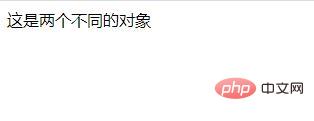 Backend Development
Backend Development
 PHP Problem
PHP Problem
 What are design patterns in PHP? What is a singleton? how to use?
What are design patterns in PHP? What is a singleton? how to use?
What are design patterns in PHP? What is a singleton? how to use?
The last article introduced you to "How to use PHP to make an MVC framework in general process". This article continues to introduce to you what is a design pattern in PHP? What is a singleton? how to use? It has certain reference value. Friends in need can refer to it. I hope it will be helpful to everyone.

PHP Advanced Practice-Design Pattern
Overview of Design Pattern
Design pattern (Designpattern) is a -A summary of code design experience that has been used repeatedly, is known to most people, and has been cataloged. The purpose of using design patterns is to reuse code, make the code easier to understand by others, and ensure code reliability. There is no doubt that design patterns are win-win for ourselves, others, and the system. Design patterns make code compilation truly engineering. Design patterns are the cornerstone of software engineering, just like the bricks and stones of a building.
Classic definition of pattern:Each pattern describes a problem that constantly arises in our environment, and then describes
the solution to the problem In this way, we can reuse existing solutions countless times without repeating the same work. That is, a pattern is a solution to a problem in a specific environment
There are two schools now. Some people recommend using design patterns, and some people do not recommend using design patterns!
High cohesion , Low coupling
The degree of aggregation in the class must be very high
The relationship between classes must be minimized
Let’s take the code as an example, first create A new file, then we first write a class, and then we create two objects. Whether the two objects we create now are the same space and the same object, we need to judge through the if statement. The code is as follows:
<?php
class Dog
{
}
$dog1 = new Dog();
$dog2 = new Dog();
if ($dog1=== $dog2) {
echo '这是同一个对象';
} else {
echo '这是两个不同的对象';
}The results are as follows:
 We see that the results show that they are two different objects, so we need to make a singleton;
We see that the results show that they are two different objects, so we need to make a singleton;
This class can only create one object. The application of PHP is mainly in database applications. There will be a large number of database operations in each application. Using the singleton mode, can avoid a large number of resources consumed by new operations 1. The constructor needs to be marked as private 2. Save the static member variables of the class instance 3. Get the instance Public static methods Recommended learning: " The above is the detailed content of What are design patterns in PHP? What is a singleton? how to use?. For more information, please follow other related articles on the PHP Chinese website!private function_construct( ) { }
//静态属性保存单例对象
static private $instance;
//通过静态方法来创建单例对象
static public function getInstance()
{
/ /判断$instance是否为空,如果为空,则new- 一个对象
如果不会空,则直接返回
if( !self: :$instance) {
self: :$instance = new self();
}
return self: : $instance ;
}

Hot AI Tools

Undresser.AI Undress
AI-powered app for creating realistic nude photos

AI Clothes Remover
Online AI tool for removing clothes from photos.

Undress AI Tool
Undress images for free

Clothoff.io
AI clothes remover

AI Hentai Generator
Generate AI Hentai for free.

Hot Article

Hot Tools

Notepad++7.3.1
Easy-to-use and free code editor

SublimeText3 Chinese version
Chinese version, very easy to use

Zend Studio 13.0.1
Powerful PHP integrated development environment

Dreamweaver CS6
Visual web development tools

SublimeText3 Mac version
God-level code editing software (SublimeText3)

Hot Topics
 The difference between design patterns and architectural patterns in Java framework
Jun 02, 2024 pm 12:59 PM
The difference between design patterns and architectural patterns in Java framework
Jun 02, 2024 pm 12:59 PM
In the Java framework, the difference between design patterns and architectural patterns is that design patterns define abstract solutions to common problems in software design, focusing on the interaction between classes and objects, such as factory patterns. Architectural patterns define the relationship between system structures and modules, focusing on the organization and interaction of system components, such as layered architecture.
 The wonderful use of the adapter pattern in Java design patterns
May 09, 2024 pm 12:54 PM
The wonderful use of the adapter pattern in Java design patterns
May 09, 2024 pm 12:54 PM
The Adapter pattern is a structural design pattern that allows incompatible objects to work together. It converts one interface into another so that the objects can interact smoothly. The object adapter implements the adapter pattern by creating an adapter object containing the adapted object and implementing the target interface. In a practical case, through the adapter mode, the client (such as MediaPlayer) can play advanced format media (such as VLC), although it itself only supports ordinary media formats (such as MP3).
 Analysis of the Decorator Pattern in Java Design Patterns
May 09, 2024 pm 03:12 PM
Analysis of the Decorator Pattern in Java Design Patterns
May 09, 2024 pm 03:12 PM
The decorator pattern is a structural design pattern that allows dynamic addition of object functionality without modifying the original class. It is implemented through the collaboration of abstract components, concrete components, abstract decorators and concrete decorators, and can flexibly expand class functions to meet changing needs. In this example, milk and mocha decorators are added to Espresso for a total price of $2.29, demonstrating the power of the decorator pattern in dynamically modifying the behavior of objects.
 PHP design pattern practical case analysis
May 08, 2024 am 08:09 AM
PHP design pattern practical case analysis
May 08, 2024 am 08:09 AM
1. Factory pattern: Separate object creation and business logic, and create objects of specified types through factory classes. 2. Observer pattern: allows subject objects to notify observer objects of their state changes, achieving loose coupling and observer pattern.
 What are the advantages and disadvantages of using design patterns in java framework?
Jun 01, 2024 pm 02:13 PM
What are the advantages and disadvantages of using design patterns in java framework?
Jun 01, 2024 pm 02:13 PM
The advantages of using design patterns in Java frameworks include: enhanced code readability, maintainability, and scalability. Disadvantages include complexity, performance overhead, and steep learning curve due to overuse. Practical case: Proxy mode is used to lazy load objects. Use design patterns wisely to take advantage of their advantages and minimize their disadvantages.
 How design patterns deal with code maintenance challenges
May 09, 2024 pm 12:45 PM
How design patterns deal with code maintenance challenges
May 09, 2024 pm 12:45 PM
Design patterns solve code maintenance challenges by providing reusable and extensible solutions: Observer Pattern: Allows objects to subscribe to events and receive notifications when they occur. Factory Pattern: Provides a centralized way to create objects without relying on concrete classes. Singleton pattern: ensures that a class has only one instance, which is used to create globally accessible objects.
 Application of design patterns in Guice framework
Jun 02, 2024 pm 10:49 PM
Application of design patterns in Guice framework
Jun 02, 2024 pm 10:49 PM
The Guice framework applies a number of design patterns, including: Singleton pattern: ensuring that a class has only one instance through the @Singleton annotation. Factory method pattern: Create a factory method through the @Provides annotation and obtain the object instance during dependency injection. Strategy mode: Encapsulate the algorithm into different strategy classes and specify the specific strategy through the @Named annotation.
 PHP Design Patterns: Test Driven Development in Practice
Jun 03, 2024 pm 02:14 PM
PHP Design Patterns: Test Driven Development in Practice
Jun 03, 2024 pm 02:14 PM
TDD is used to write high-quality PHP code. The steps include: writing test cases, describing the expected functionality and making them fail. Write code so that only the test cases pass without excessive optimization or detailed design. After the test cases pass, optimize and refactor the code to improve readability, maintainability, and scalability.





